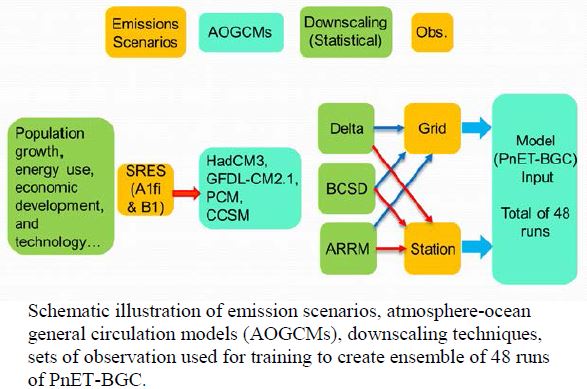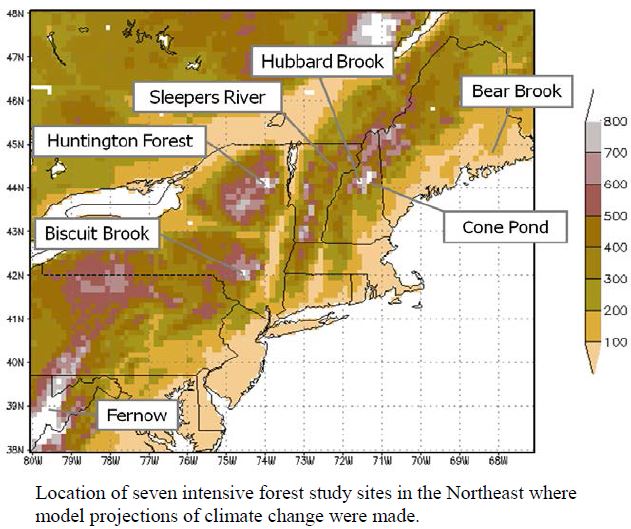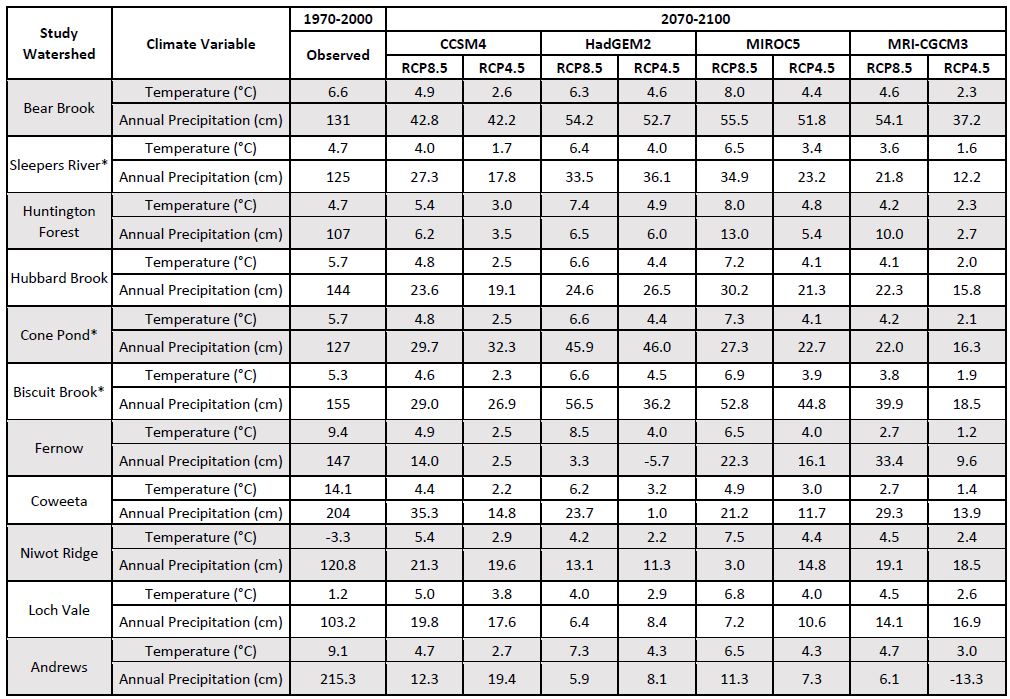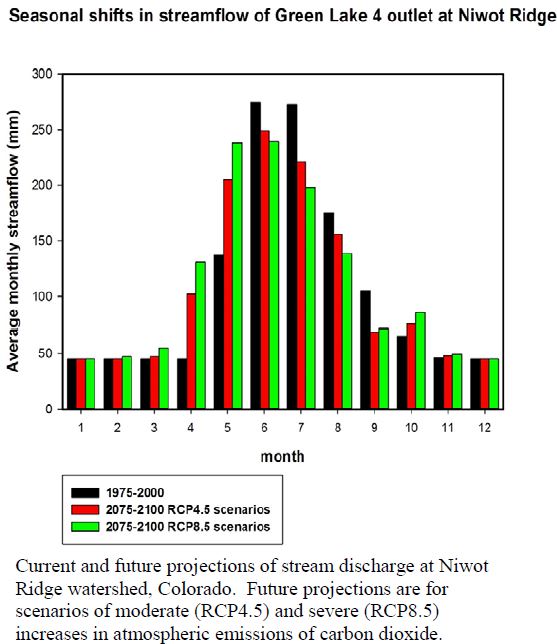Grantee Research Project Results
Final Report: Modeling of the Hydrochemical Response of High Elevation Watersheds to Climate Change and Atmospheric Deposition
EPA Grant Number: R834188Title: Modeling of the Hydrochemical Response of High Elevation Watersheds to Climate Change and Atmospheric Deposition
Investigators: Driscoll, Charles T. , Campbell, John L. , Pourmokhtarian, Afshin , Hayhoe, Katharine , Wu, Wei , Dong, Zheng
Institution: Syracuse University , University of Southern Mississippi , USDA , Towson University
Current Institution: Syracuse University , Towson University , USDA , University of Southern Mississippi
EPA Project Officer: Packard, Benjamin H
Project Period: August 1, 2009 through July 31, 2012 (Extended to July 31, 2014)
Project Amount: $800,000
RFA: Consequences of Global Change for Water Quality (2008) RFA Text | Recipients Lists
Research Category: Aquatic Ecosystems , Ecological Indicators/Assessment/Restoration , Watersheds , Water , Climate Change
Objective:
Summary/Accomplishments (Outputs/Outcomes):
The fully integrated coupled hydrological and biogeochemical model (PnET-BGC) was applied to evaluate the effects of climate change and increasing concentrations of atmospheric carbon dioxide at diverse, intensively studied, high-elevation watersheds and to evaluate aspects of these applications. Coarse scale projections from global circulation models were downscaled to local watersheds and applied as inputs to the biogeochemical model, PnET-BGC.
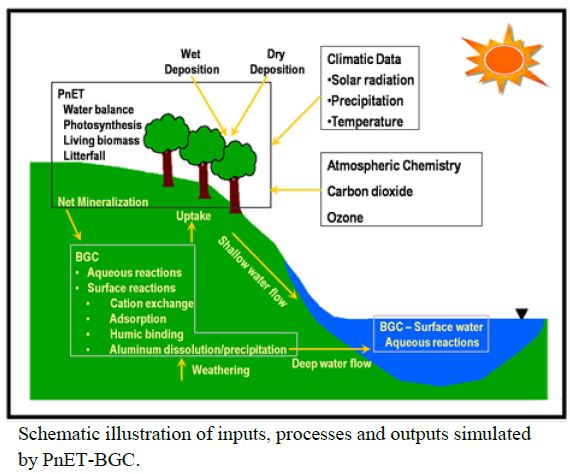
Table: Summary of climate projections of change in annual air temperature and annual precipitation from statistically downscaled atmospheric-ocean global circulation model output for watersheds considered in this study. The value shown for each scenario is the difference between the mean of measured values for the reference period (1970-2000) and the simulation period 2070-2100. Note that for sites that do not have measured values for the entire period of 1970-2000, measured data for a shorter period are used.
We also provided a new framework for assessing climate change impacts based on incremental projected increases in temperature. Across all sites, model projections of decreases in soil carbon and nitrogen pools showed a strong negative relationship with temperature. The responses of other state variables (e.g., net primary production, streamwater discharge) are nonlinear due to effects of precipitation quantity and soil water and linkages with temperature change. Nevertheless, this framework could help guide policy makers and managers to make appropriate decisions to mitigate effects and ensure the continuation of ecosystem services and facilitate adaptation to changing climate. Finally, it is essential that experimental forested watersheds such as those investigated be maintained and preserved. Long-term monitoring and measurements of meteorology, biomass, hydrology, and stream chemistry at these intensive sites is not only necessary for model parameterization and testing but it is essential to detect climate change signals over time.
Conclusions:
Journal Articles on this Report : 5 Displayed | Download in RIS Format
| Other project views: | All 26 publications | 7 publications in selected types | All 6 journal articles |
|---|
| Type | Citation | ||
|---|---|---|---|
|
|
Campbell JL, Driscoll CT, Pourmokhtarian A, Hayhoe K. Streamflow responses to past and projected future changes in climate at the Hubbard Brook Experimental Forest, New Hampshire, United States. Water Resources Research 2011;47(2):W02514 (15 pp.). |
R834188 (2010) R834188 (2011) R834188 (2013) R834188 (Final) |
Exit Exit |
|
|
Pourmokhtarian A, Driscoll CT, Campbell JL, Hayhoe K. Modeling potential hydrochemical responses to climate change and increasing CO2 at the Hubbard Brook Experimental Forest using a dynamic biogeochemical model (PnET-BGC). Water Resources Research 2012;48(7):W07514 (13 pp.). |
R834188 (2011) R834188 (2012) R834188 (2013) R834188 (Final) |
Exit Exit Exit |
|
|
Pourmokhtarian A, Driscoll CT, Campbell JL, Hayhoe K, Stoner AM. The effects of climate downscaling technique and observational data set on modeled ecological responses. Ecological Applications 2016;26(5):1321-1337. |
R834188 (Final) |
Exit Exit |
|
|
Pourmokhtarian A, Driscoll CT, Campbell JL, Hayhoe K, Stoner AM, Adams MB, Burns D, Fernandez I, Mitchell MJ, Shanley JB. Modeled ecohydrological responses to climate change at seven small watersheds in the northeastern United States. Global Change Biology 2017;23(2):840-856. |
R834188 (Final) |
Exit Exit |
|
|
Wu W, Driscoll CT. Impact of climate change on three-dimensional dynamic critical load functions. Environmental Science & Technology 2010;44(2):720-726. |
R834188 (Final) |
Exit Exit Exit |
Supplemental Keywords:
Climate change, evapotranspiration, hydrology, stream nutrient loss, nutrient uptake, primary productivity, soil organic matter, stream flow quantity and distribution, watersheds , RFA, Air, Atmosphere, Air Pollution Effects, climate change, Global Climate Change, hydrologic models, environmental monitoringProgress and Final Reports:
Original AbstractThe perspectives, information and conclusions conveyed in research project abstracts, progress reports, final reports, journal abstracts and journal publications convey the viewpoints of the principal investigator and may not represent the views and policies of ORD and EPA. Conclusions drawn by the principal investigators have not been reviewed by the Agency.
Project Research Results
- 2013 Progress Report
- 2012 Progress Report
- 2011 Progress Report
- 2010 Progress Report
- Original Abstract
6 journal articles for this project

